An effectively executed quick passing game can turn a good running offense into a great running offense. If you asked any football coach, “would you like to complete more passes?” You would get an overwhelming response of “YES!”. Completing passes allows teams to move the chains, score more points and win more games. Even teams that want to run the football whenever possible will at some point need to be able to complete a pass.
As NFL running back Adrian Peterson stated:
When you are a "spread to run" team, the best way to keep a defense honest and keep defenders out of the box is by utilizing all of your receivers and forcing the defense to cover them. Utilizing Grass Routes is an easy way to spread the football. Grass Routes are also an easy for your Quarterbacks and wide receivers to play pitch and catch, while giving the QB alot of confidence.
Grass Routes
The grass concept route combination is very simple. The Call Side #1 receiver is going to run a fade/go route. All other receivers are going to run 'Grass' routes in the called direction. A grass route involves sprinting 6 yards and turning in the called direction.
Once the receiver turns, he is going to do one of 2 things:
- Sit and show the QB your numbers because you are already IN the open ‘grass’.
- Continue to run flat at 6 yards TO the open ‘grass’.
It is that simple. So how does the receiver know what to do?
Pre-Snap, the receiver should be able to locate the open grass. The defense is going to move at the snap, but the pre-snap grass area between 2 defenders will most likely remain the open grass once the defenders move into their drops.
Post Snap, the reciever will run away from defenders or sit away from the closest defender. The route is totally dependent upon the location of the defender AFTER the receiver has sprinted his 6 yards and turned in the called direction.
The grass route in our Right formation would look like this:
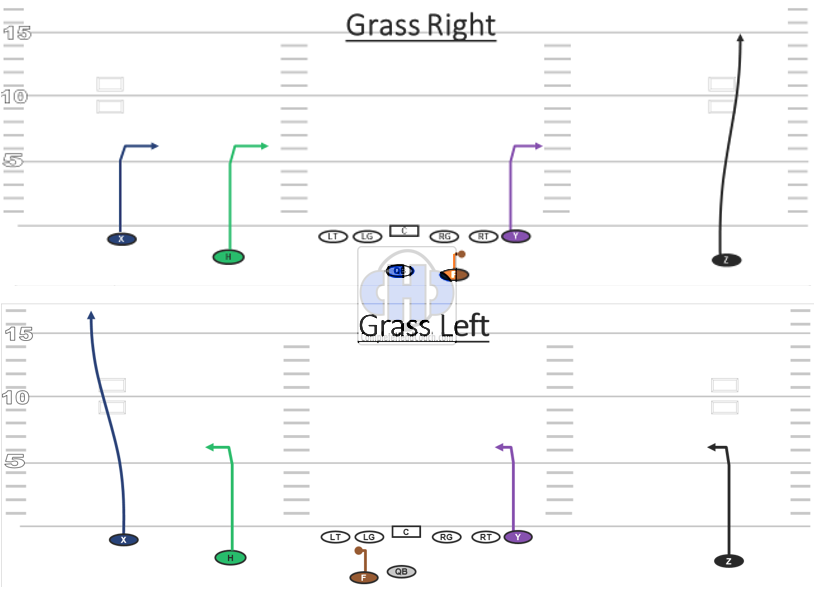
Here is the Grass Route out of Right Hop:
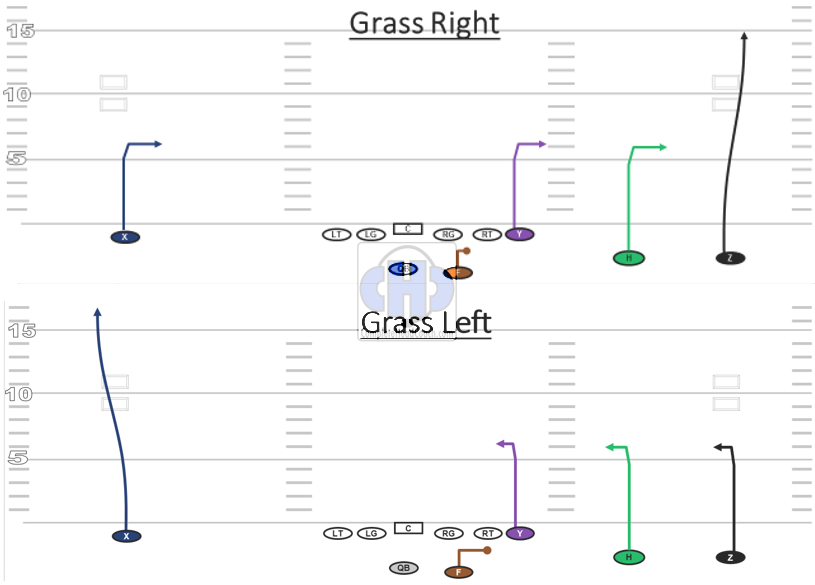
Here is the grass Route out of Right Flip:

Each of these formations will force a different defensive alignment that will cause different areas of the field to become the open grass.
Defensive Alignment
Now, let’s talk a little about defensive alignment. A typical zone defense regardless of coverage will align a defender over every receiver. For the sake of this post, we will focus on 3 deep coverage. The question we need to anwer is, "which defender is tight to the line of scrimmage and which defender is deep off the ball?"
Running Grass Right against a basic 4-4 cover 3 defense would look like this:
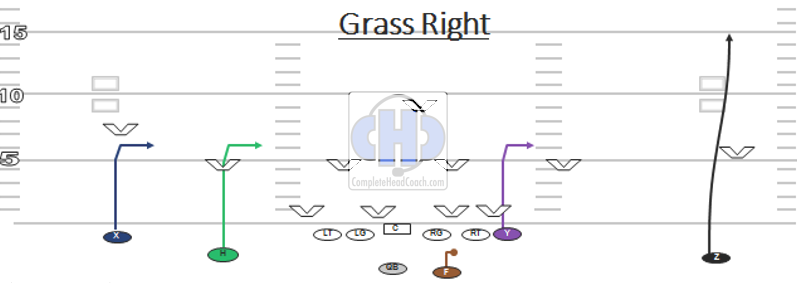 Pre-Snap: The QB will scan the field. The best pre-snap grass in the picture above is to the left between the OLB and the Corner. The QB is thinking pre-snap, “I am throwing to the Outside receiver.” The QB will then Key the player up tight covering the #2 receiver. He is typically the flat player in a 4-4 defense running 3 deep zone coverage.
Pre-Snap: The QB will scan the field. The best pre-snap grass in the picture above is to the left between the OLB and the Corner. The QB is thinking pre-snap, “I am throwing to the Outside receiver.” The QB will then Key the player up tight covering the #2 receiver. He is typically the flat player in a 4-4 defense running 3 deep zone coverage.
The QB/WR read is as follows:
• If the key does NOT sprint straight out to the flat, the QB will catch and throw to #1 on a Hitch type of route. The receiver will want to sit in the grass and not run into the flat defender.
• If the key sprints straight to the flat, the QB will throw to the #2 receiver on a hitch type of route. The receiver will want to sit in the grass and not run into the hook/curl defender.
Right Hop Formation vs. Cover 3
Using a TE Trips Formation, the play would look like this:
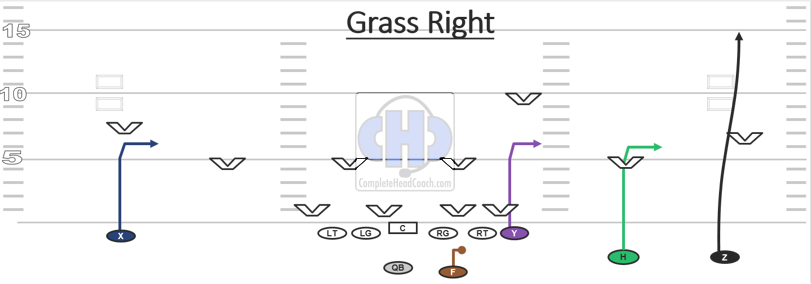 Pre-Snap: The QB will scan the field. The first thing the QB will find is the alignment of the OLB on the single receiver side. Most of the time, a team’s best receiver is isolated so the QB will want to get the ball to him first. If the OLB is tight to the box and the Corner has some depth, the QB will most likely choose the single receiver side. In the diagram above, the OLB is splitting the difference between the EMLOS and the receiver. Because of this alignment, the QB would probably choose to read 3 receiver side.
Pre-Snap: The QB will scan the field. The first thing the QB will find is the alignment of the OLB on the single receiver side. Most of the time, a team’s best receiver is isolated so the QB will want to get the ball to him first. If the OLB is tight to the box and the Corner has some depth, the QB will most likely choose the single receiver side. In the diagram above, the OLB is splitting the difference between the EMLOS and the receiver. Because of this alignment, the QB would probably choose to read 3 receiver side.
The pre-snap grass the QB is seeing in this case is located in 2 places. There is open grass between the Y and H, as well as open grass between the H and Z. The QB will then Key the player up tight covering the #2 receiver. This player would typically be the flat player in 3 deep zone coverage.
The read is as follows:
- If the key does not sprint straight out to the flat, the QB will catch and throw to #2 receiver on a on an OUT route. The receiver will want to run to the open grass and away from the defender over him.
- If the key sprints straight to the flat, the QB will throw to the #3 receiver on an Out type of route. In this situation, with the #3 receiver being an attached TE, the receiver will want to run out to the open grass and create separation from the inside linebacker.
Grass Routes out of Right Flip Formation vs. Cover 3
Using our Flip Formation, the grass play would look like this:
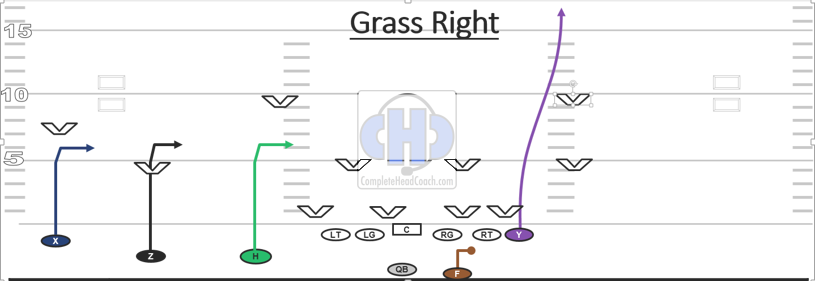 Pre-Snap: The QB will scan the field. In this case, the TE is the single receiver and #1 to the call, so he will be running a fade/go route. In the diagram above, the QB would leave the TE and choose to read the 3 receiver side.
Pre-Snap: The QB will scan the field. In this case, the TE is the single receiver and #1 to the call, so he will be running a fade/go route. In the diagram above, the QB would leave the TE and choose to read the 3 receiver side.
Pre-snap, the QB is seeing open grass between the Z and H as well as open grass between the X and Z. Knowing that the H will be turning in towards the ILB, the QB will probably be thinking to throw to either the #1 or #2 receiver in this case, although he can choose to throw to #3 immediately if his spacing is far enough from the ILB. Keep in mind that the ILB is a run first player and will probably have some read steps at the snap of the ball.
Assuming the QB is thinking the throw to #1 or #2, the QB will then Key the player up tight covering the #2 receiver. Again, this player would typically be the flat player in 3 deep zone coverage.
The read is as follows:
- If the key does not sprint straight out to the flat, the QB will catch and throw to #1 receiver on a Hitch type of route. The receiver will want to SIT in the open grass.
- If the key sprints straight to the flat, the QB will throw to the #2 receiver on a Hitch type of route. He may shuffle in a little bit, but would not want to run IN very far to stay away from the #3 receiver and the ILB covering him. Keeping this spacing is important for an easy throw and catch.
Grass Routes vs. other coverages
This concept is good against any coverage. If you see Cover ZERO, you may find your QB taking more shots deep and the receivers would be running away from defenders rather than sitting. If you see Cover 2, the grass area will change, but the premise will stay the same. The QB will still throw to the open grass and the receivers will still run to or sit in the open grass. The coverage really doesn’t matter, although you may want to run the play in a certain direction or out of a certain formation to gain an advantage against an alignment.
In the diagram below, a 4-3 with 2 high safety's the QB is thinking one of 2 things:
- Throw the Go quick and into the hole between the Safety and the corner. If the QB makes this choice and the corner drops at the snap, his check down would be the TE running an Out away from the ILB.
- Throw quick to the H, who would be considered uncovered.
In the diagram below, a 3-4 with 2 high safety's the QB is thinking one of 2 things:
- Throw the Go quick and into the hole between the Safety and the corner.
- Key the defender over #2 and throw opposite his drop.
Below is some video of the Grass Concept out of multiple formations against multiple coverage's.
Overall, the grass concept is very easy to install, practice, run and allows your QB to build confidence with easy completions. You could also replace the Fade/Out or All Hitch combinations with the Grass concept. You can achieve the same results with less plays to practice and more time to perfect your execution.
If you liked this post, feel free to share it with the share buttons below.
Thanks for reading.
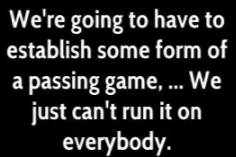
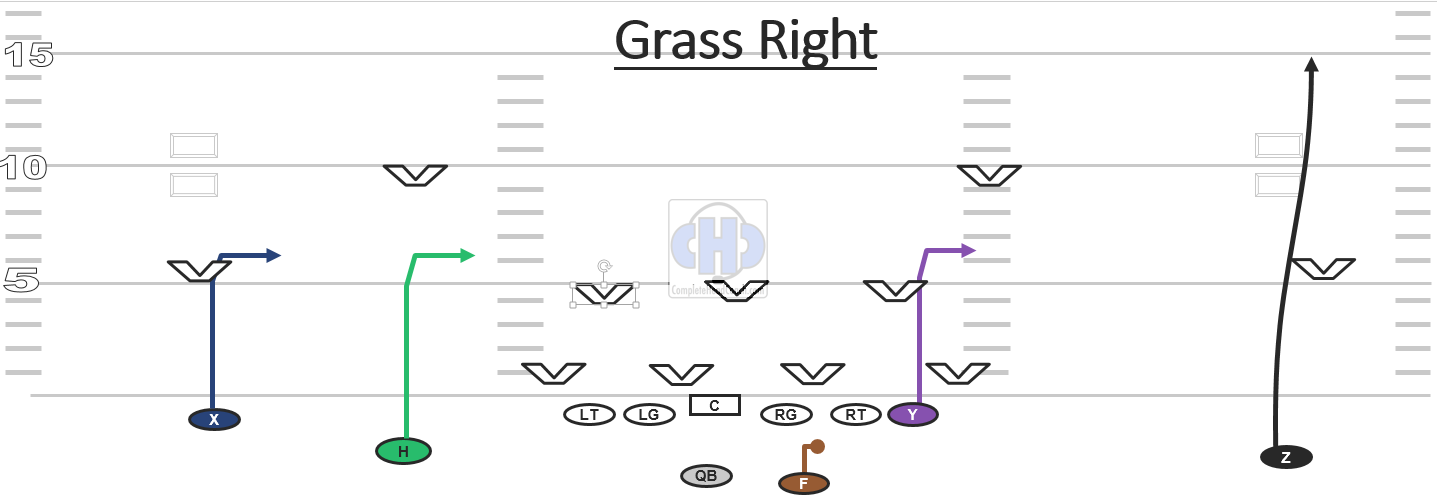
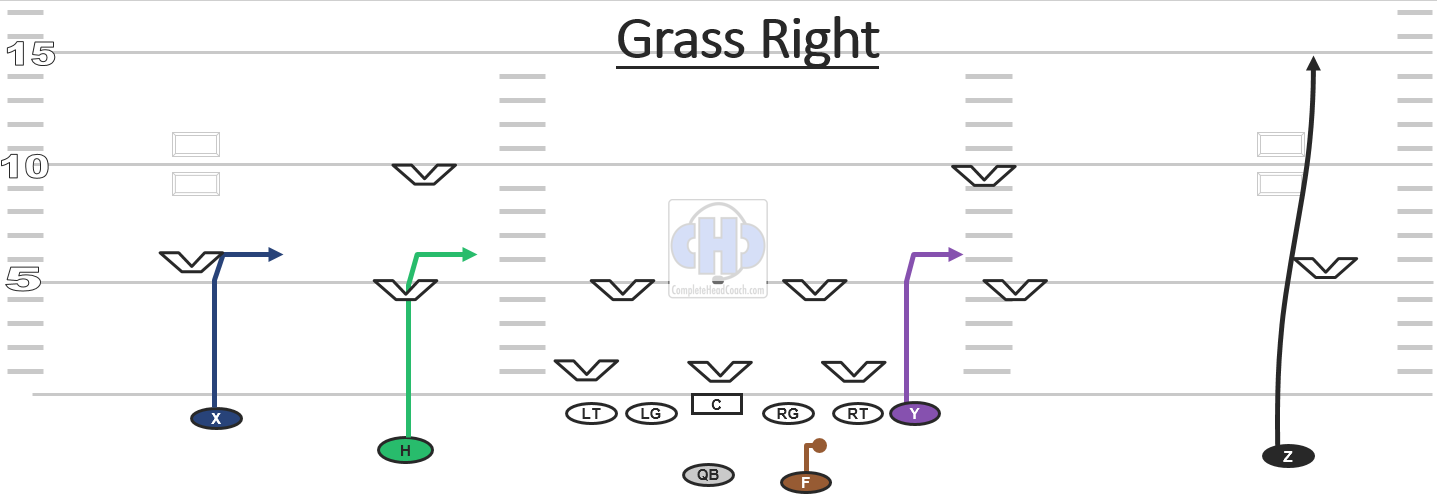
Leave a Reply